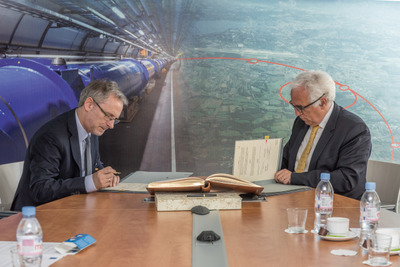 |
Professor Dr. Krzysztof Kurek, NCBJ Director General (left), and Dr. Frédérick Bordry, CERN Director for Accelerator Technologies (right).
Photo courtesy of CERN |
| |
Geneva, Switzerland - April 20, 2016
Today, Professor Dr. Krzysztof Kurek, Polish National Centre for Nuclear Research (Narodowe Centrum Badań Jądrowych - NCBJ) Director General, and Dr. Frédérick Bordry, the European Council for Nuclear Research (CERN) Director for Accelerator Technologies, signed an agreement on future CERN/NCBJ cooperation.
Particular emphasis was put on further R&D works aimed to improve performance of the Large Hadron Collider (LHC) accelerator.
The agreement has set a framework for further NCBJ/CERN cooperation.
By virtue of the agreement Świerk scientists/technicians shall be engaged more actively not only in CERN scientific endeavours, but also in R&D works aimed to improve LHC performance.
“The just reached agreement would not be possible if the quality of works done by Polish scientists and technicians as our contribution to the development and operation of LHC during its first run has not been evaluated as high” – pointed out
Professor Krzysztof Kurek, NCBJ Director General.
“Our partners has also highly appreciated our contribution to efforts to upgrade the facility, including delivery of some elements for the first accelerator in the chain of devices supplying LHC with beams of particles”.
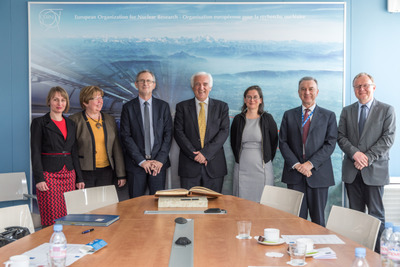 |
CERN and NCBJ cooperation agreement extender.
Photo courtesy of CERN |
| |
The two year-long break in operation (2013-2015) was used to fix some key LHC elements and to improve its overall performance.
Every orbit-controlling superconducting magnet has been tested, some of them have been replaced.
A new cryogenic system supplying the magnets has been developed and constructed.
A safer vacuum system, better solutions capable to focus particle beams and to boost particle energy, and better radiation-resistant electronic circuitry have been implemented.
Since LHC is a very complicated machine, the works had to be conducted very accurately.
Nothing strange that a number of high-class experts in various fields were involved, and the work were time-consuming.
Polish groups actively participated in works of the experts.
After that thorough upgrading process, LHC was re-started in 2015.
The most significant results of the upgrade include increase of particle energy to 6.5 TeV and increase of frequency of collisions.
Researchers hope that during the LHC Run 2 scheduled till 2017 some more accurate information on Higgs boson, dark matter, super-symmetry, anti-matter, quark-gluon plasma, and/or exotic particles will become available.
Physicists assume that LHC will remain operational for another 20 years, including a few scheduled maintenance/upgrade breaks.
Future plans will depend on scientific discoveries, and on organizational/technological/economic capabilities.
LHC is the most complicated machine ever constructed by man.
It is a kind of microscope that helps to investigate very small objects of the world.
To that end two beams of proton/lead ions running in opposite directions with extremely high energies are brought to collision.
In order that could happen, an entire chain of accelerators that gradually accelerate the particles to ever higher energies is needed.
In case of protons all begins from gaseous hydrogen, atoms of which are composed of just one proton and one electron.
Every few hours a portion of gas is taken from a small pressurized cylinder and hydrogen atoms are stripped of their electrons (ionized).
The remaining protons are injected into a linear accelerator that accelerates them to a velocity of about 30% of light velocity.
The next accelerator (PS Booster) increases proton energy almost 30 times.
Each of the subsequent accelerators on the protons path (Proton Synchrotron PS, then Proton Super Synchrotron SPS) boost proton energy about 20 times.
Finally the protons are injected into the LHC tunnel.
Each day LHC consumes merely a few nanograms (10-9 g) of hydrogen.
In other words 1 gram of gaseous hydrogen would suffice for about one million years of operation.
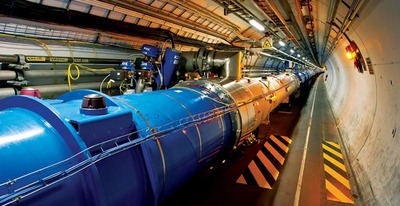 |
The Large Hadron Collider is the world's largest and most powerful particle accelerator.
Photo courtesy of CERN |
| |
LHC forms the injected particles into two beams moving opposite directions.
They travel along two parallel circular tubes in a tunnel of 27 km circumference about 100 m below the ground (the ring).
Diameter of each of the tubes is a few centimetres.
Ultra-high vacuum must be kept at all times inside both tubes or else the particles travelling inside would quickly scatter on gas molecules.
Target velocity of protons accelerated in LHC is 0.999999991 of light velocity.
At that velocity protons orbit the ring more than 11,000 times every second.
Very high magnetic fields are necessary to bend trajectories of high-energy particles along the ring.
The field is generated by more than 1,200 mighty dipole electromagnets, coils of which conduct electric currents on the order of several thousand Amperes (comparable to a small lightning).
Such currents are impractical unless the magnets are in superconducting state, i.e. their coils exhibit no electrical resistance.
To be in superconducting state, magnets must be cooled down to a very low temperature of just 1.9 Kelvin (degrees above absolute zero).
It means that interior of LHC is colder than extra-terrestrial open space.
Beside dipole magnets that route the particles along the tubes, LHC is also equipped with a number of beam focussing/geometry correcting magnets that prevent beam divergence and focus the beams in designated collision points.
Protons orbit the ring grouped in bunches (packets).
There are about 100 billion particles in each bunch.
More than 5,600 bunches mutually separated by about 7 metres may orbit simultaneously the ring.
Energy of all orbiting bunches corresponds to explosion of 80 kg of TNT, or a train of 800 tonnes mass moving with velocity of 150 km/h.
It is a quite challenging task to control so big energies inside so complicated facility.
Particles accelerated to their final energy may orbit the ring for many hours.
However, their number is steadily decreasing because periodically beams are intentionally collided within ring sections encircled by detectors, as well as because some particles in the beams inevitable scatter on residue gas molecules within the entire accelerator tubes.
After a few hours beams are diverted outside the ring and directed on some graphite blocks where they stop.
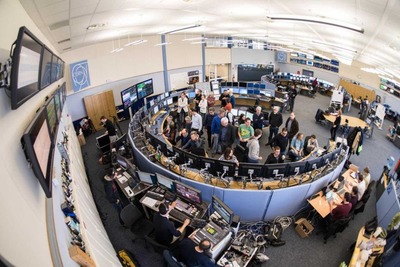 |
CERN Control Room
Photo courtesy of CERN |
| |
Kinetic energy of colliding primary particles (protons or lead nuclei) is converted into new, mostly unstable, particles.
They are identified, their parameters (electric charge, velocity, mass, energy) are measured, and their tracks are reconstructed on the basis of various data logged by detectors.
Really heavy particles live less than 1 picosecond (10
-12 s), therefore they cannot be observed by any detection setup.
They can be studied only indirectly by analysis of parameters of products of their decays.
Opposite beams are collided only in sections of the ring encircled by detectors developed by various teams of experimentalists (in physicists’ jargon: experiments or collaborations).
The four main LHC detectors include ATLAS, CMS, ALICE and LHCb. 46 m long, 25 m wide, and 25 m tall ATLAS is the largest LHC detector.
It weighs 7,000 tonnes.
Its 8 superconducting magnetic coils, each 25 m long, form a cylinder around the accelerator tube routed through its centre.
CMS is a bit smaller but almost twice as heavy.
Total proton-proton collision rate in LHC may reach billions per second, much more that detector data logging capabilities.
Besides, majority of the collisions produce only uninteresting events (from the researchers’ point of view).
Therefore special electronic circuitry – called trigger – is needed in every experiment to select and log only interesting events.
Triggers must be very fast to make decisions on-the-fly.
The name CERN
The name CERN is derived from the acronym for the French "Conseil Européen pour la Recherche Nucléaire", or European Council for Nuclear Research, a provisional body founded in 1952 with the mandate of establishing a world-class fundamental physics research organization in Europe.
At that time, pure physics research concentrated on understanding the inside of the atom, hence the word "nuclear".
Today, our understanding of matter goes much deeper than the nucleus, and CERN's main area of research is particle physics – the study of the fundamental constituents of matter and the forces acting between them.
Because of this, the laboratory operated by CERN is often referred to as the European Laboratory for Particle Physics.
About National Centre for Nuclear Research (NCBJ)
National Centre for Nuclear Research (Narodowe Centrum Badań Jądrowych - NCBJ) came into existence on September 1, 2011 in effect of merging the former Institute of Atomic Energy POLATOM with the former Andrzej Sołtan Institute for Nuclear Studies.
NCBJ pure/applied research profile combines nuclear power-related studies with various fields of sub-atomic physics (elementary particle physics, nuclear physics, hot plasma physics etc.).
The Centre is strongly involved in developing nuclear technologies and promoting practical applications of nuclear physics methods.
Major market products manufactured in the Centre include radiopharmaceuticals and a range of particle accelerators for science, various industry sectors and medicine.
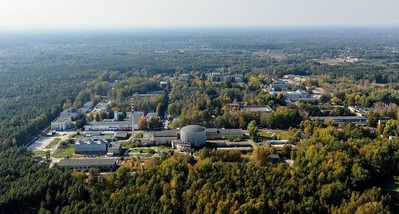 |
NCBJ bird's eye view
Photo courtesy of NCBJ |
| |
The Centre is an IT and R&D background infrastructure indispensable to provide expert support for decision-makers in the project to develop in the coming years nuclear power industry in Poland.
National Centre for Nuclear Research is the largest research Institute in Poland.
We are also the only Polish research institution operating a nuclear reactor (the MARIA reactor).
Currently we are hiring over 1000 employees.
Our research staff includes about 70 Professors and holders of the Dr hab. post-doctoral degree, as well as over 120 PhDs.
Sources:
The European Council for Nuclear Research (CERN)
http://home.cern
CERN Press Office
CH - 1211 Geneva 23
Switzerland
Email:
Press.Office@cern.ch
National Centre for Nuclear Research (NCBJ)
http://www.ncbj.gov.pl/
ASTROMAN Magazine - 2016.03.09
Prezydent RP Andrzej Duda w Narodowym Centrum Badań Jądrowych
http://www.astroman.com.pl/index.php?mod=magazine&a=read&id=2039
ASTROMAN Magazine - 2014.11.22
Poland's NCBJ thermal-to-14 MeV neutron converter is a sole device of its kind operated in the world
http://www.astroman.com.pl/index.php?mod=magazine&a=read&id=1834
ASTROMAN Magazine - 2014.07.08
Poland's PGE EJ1 has selected AMEC Nuclear UK as Owner's Engineer to support the first Polish Nuclear Power Plant build project 3,000 MWe
http://www.astroman.com.pl/index.php?mod=magazine&a=read&id=1752
ASTROMAN Magazine - 2014.07.05
TOSHIBA and GDF SUEZ Complete NuGen Deal, Europe's Largest New Nuclear Energy Project in Northwest England
http://www.astroman.com.pl/index.php?mod=magazine&a=read&id=1747
ASTROMAN Magazine - 2014.07.01
AMEC wins consultancy contract for UAE nuclear energy programme
http://www.astroman.com.pl/index.php?mod=magazine&a=read&id=1750
ASTROMAN Magazine - 2014.06.15
Prof. Jacek Jagielski: Za 30 lat reaktory jądrowe czwartej generacji będą wytwarzały 85% energii na świecie
http://www.astroman.com.pl/index.php?mod=magazine&a=read&id=1734
ASTROMAN Magazine - 2014.05.23
VI Europejski Kongres Gospodarczy 2014: Bezpieczeństwo i solidarność w energetyce zamiast lansowanej doktryny
http://www.astroman.com.pl/index.php?mod=magazine&a=read&id=1717
ASTROMAN Magazine – 2014.05.15
Elektrownie jądrowe: tanie, bezemisyjne i bezpieczne
http://www.astroman.com.pl/index.php?mod=magazine&a=read&id=1712
ASTROMAN Magazine – 2014.05.01
Prof. Andrzej Strupczewski: Jeżeli nas stać na czystą energię, czyli słońce, wiatr, energia jądrowa - to najtańsza jest energia jądrowa
http://www.astroman.com.pl/index.php?mod=magazine&a=read&id=1704
ASTROMAN Magazine – 2014.04.27
GE's Energy Investing Unit Exceeds $10 Billion Renewable Energy Milestone, Generating Clean Power, Jobs
http://www.astroman.com.pl/index.php?mod=magazine&a=read&id=1703
ASTROMAN Magazine – 2014.02.12
Kajetan Różycki from NCBJ in Poland appointed as Chairman of Nuclear Cogeneration Industrial Initiative - Task Force
http://www.astroman.com.pl/index.php?mod=magazine&a=read&id=1652
ASTROMAN Magazine - 2012.12.01
Polski reaktor jądrowy Maria ratuje światową medycynę nuklearną
http://www.astroman.com.pl/index.php?mod=magazine&a=read&id=1358
ASTROMAN Magazine - 2012.09.22
Professor Agnieszka Zalewska elected President of CERN Council, is the first woman to fill this position
http://www.astroman.com.pl/index.php?mod=magazine&a=read&id=1317
ASTROMAN Magazine - 2012.07.22
Spintronika: Powstał nowy typ tranzystora, owoc polskiej technologii
http://www.astroman.com.pl/index.php?mod=magazine&a=read&id=1281
ASTROMAN Magazine - 2012.07.05
CERN experiments observe particle consistent with long-sought Higgs boson
http://www.astroman.com.pl/index.php?mod=magazine&a=read&id=1266
ASTROMAN Magazine - 2012.05.06
Prof. dr hab. Andrzej Udalski jest członkiem zagranicznym Amerykańskiej Akademii Nauk (U.S. National Academy of Sciences)
http://www.astroman.com.pl/index.php?mod=magazine&a=read&id=1235
ASTROMAN Magazine – 2012.01.24
Profesor dr Jacek M. Żurada Przewodniczącym Komisji Oceny Periodyków IEEE w USA
http://www.astroman.com.pl/index.php?mod=magazine&a=read&id=1156
ASTROMAN Magazine - 2011.09.18
GE Hitachi Nuclear Energy and Fluor Corporation Team Up on Polish Nuclear Power Plant Project
http://www.astroman.com.pl/index.php?mod=magazine&a=read&id=1059
ASTROMAN Magazine - 2011.09.18
World's leading nuclear power companies adopt principles of conduct
http://www.astroman.com.pl/index.php?mod=magazine&a=read&id=1058
ASTROMAN Magazine - 2011.09.08
GE Hitachi Nuclear Energy Expands Workforce Training Collaboration with Poland's University Sector
http://www.astroman.com.pl/index.php?mod=magazine&a=read&id=1052
ASTROMAN Magazine - 2011.03.06
Japońskie Technologie Środowiskowe - międzynarodowa konferencja w Warszawie
http://www.astroman.com.pl/index.php?mod=magazine&a=read&id=911
ASTROMAN Magazine - 2010.07.18
International Nuclear Energy Development of Japan
http://www.astroman.com.pl/index.php?mod=magazine&a=read&id=761
ASTROMAN Magazine - 2010.05.06
Westinghouse and PGE Agree to Partner on Delivering Nuclear Energy Solutions for Poland
http://www.astroman.com.pl/index.php?mod=magazine&a=read&id=715
ASTROMAN Magazine - 2010.03.27
Polacy opracowali nowatorski czujnik wykrywający melaminę
http://www.astroman.com.pl/index.php?mod=magazine&a=read&id=686
ASTROMAN Magazine - 2010.03.06
Wielki Zderzacz Hadronów (LHC) w CERN ponownie w akcji
http://www.astroman.com.pl/index.php?mod=magazine&a=read&id=674
ASTROMAN Magazine - 2010.02.08
Polscy naukowcy modernizują akceleratory w CERN
http://www.astroman.com.pl/index.php?mod=magazine&a=read&id=660
Editor-in-Chief of ASTROMAN magazine: Roman Wojtala, Ph.D.

